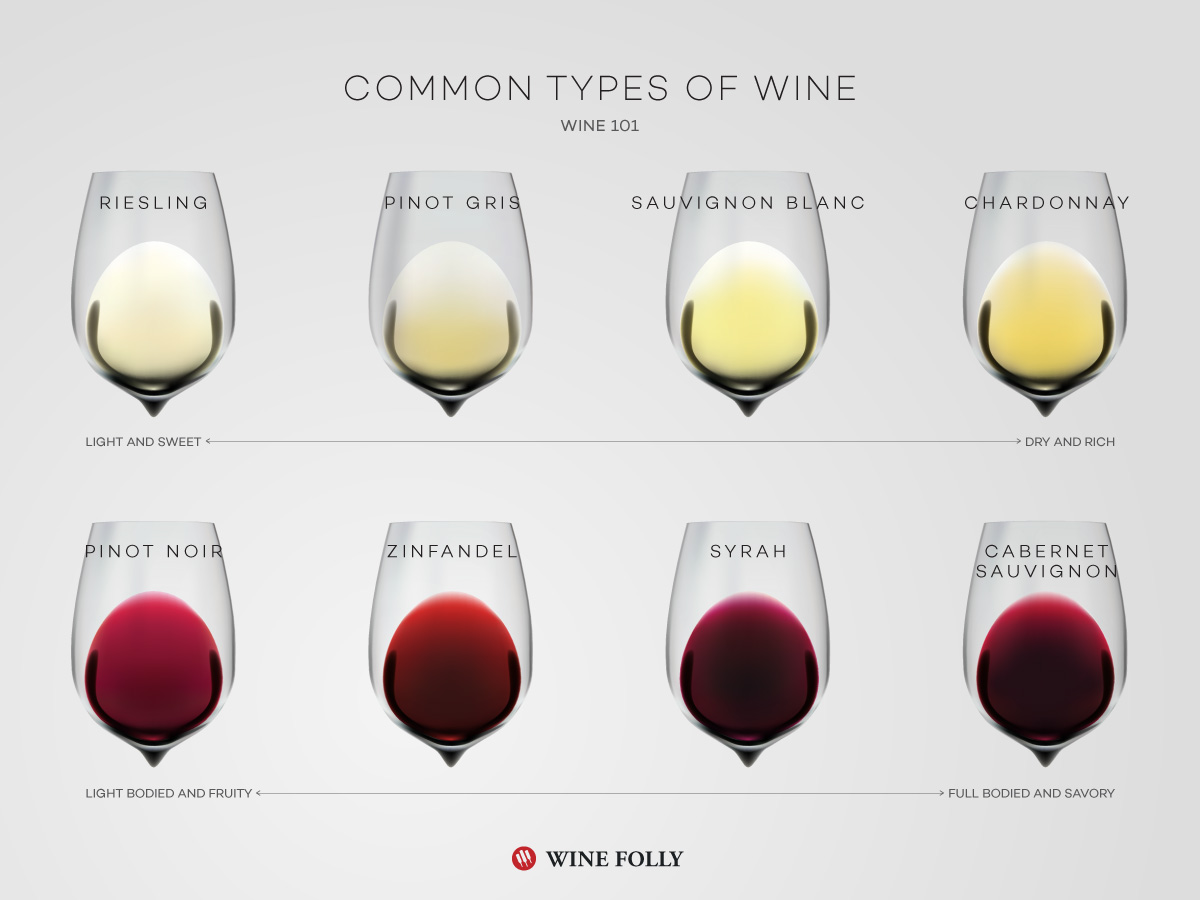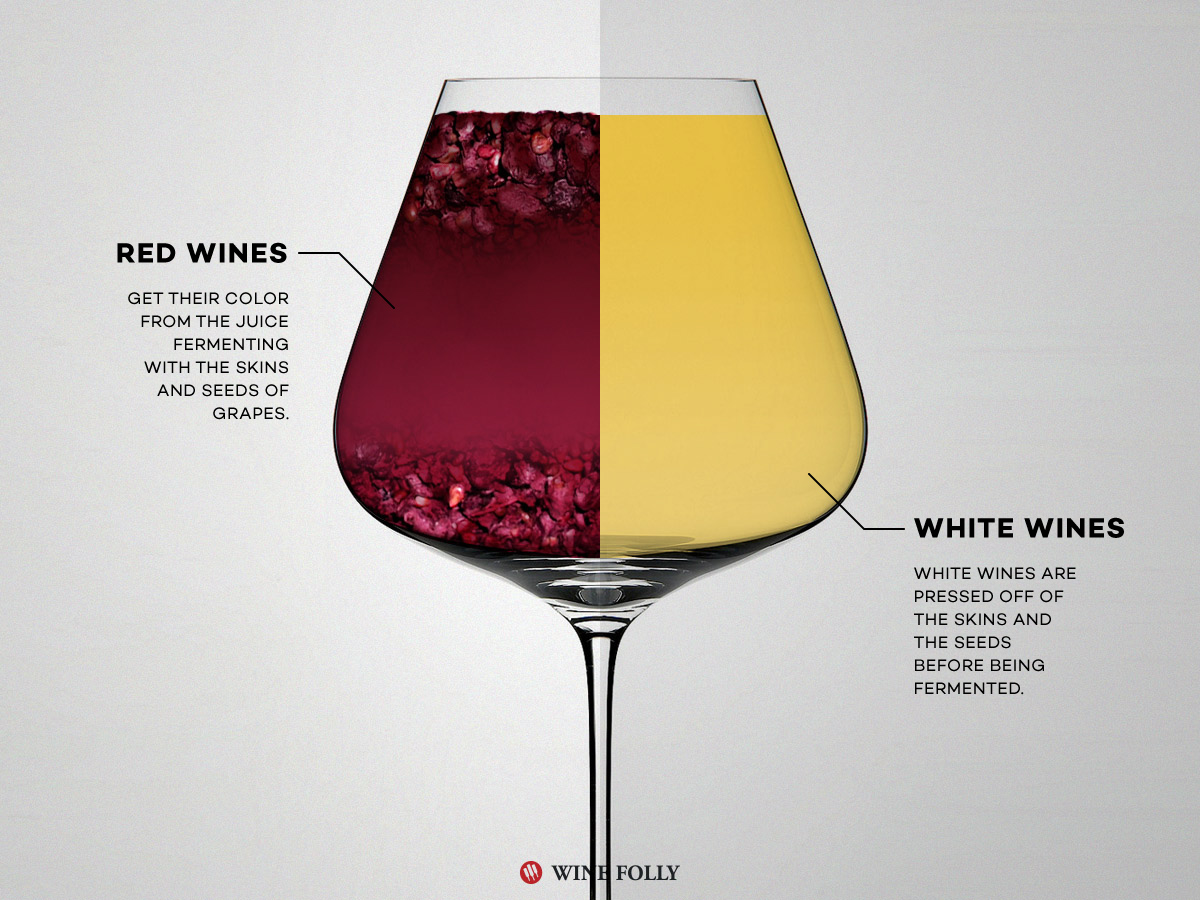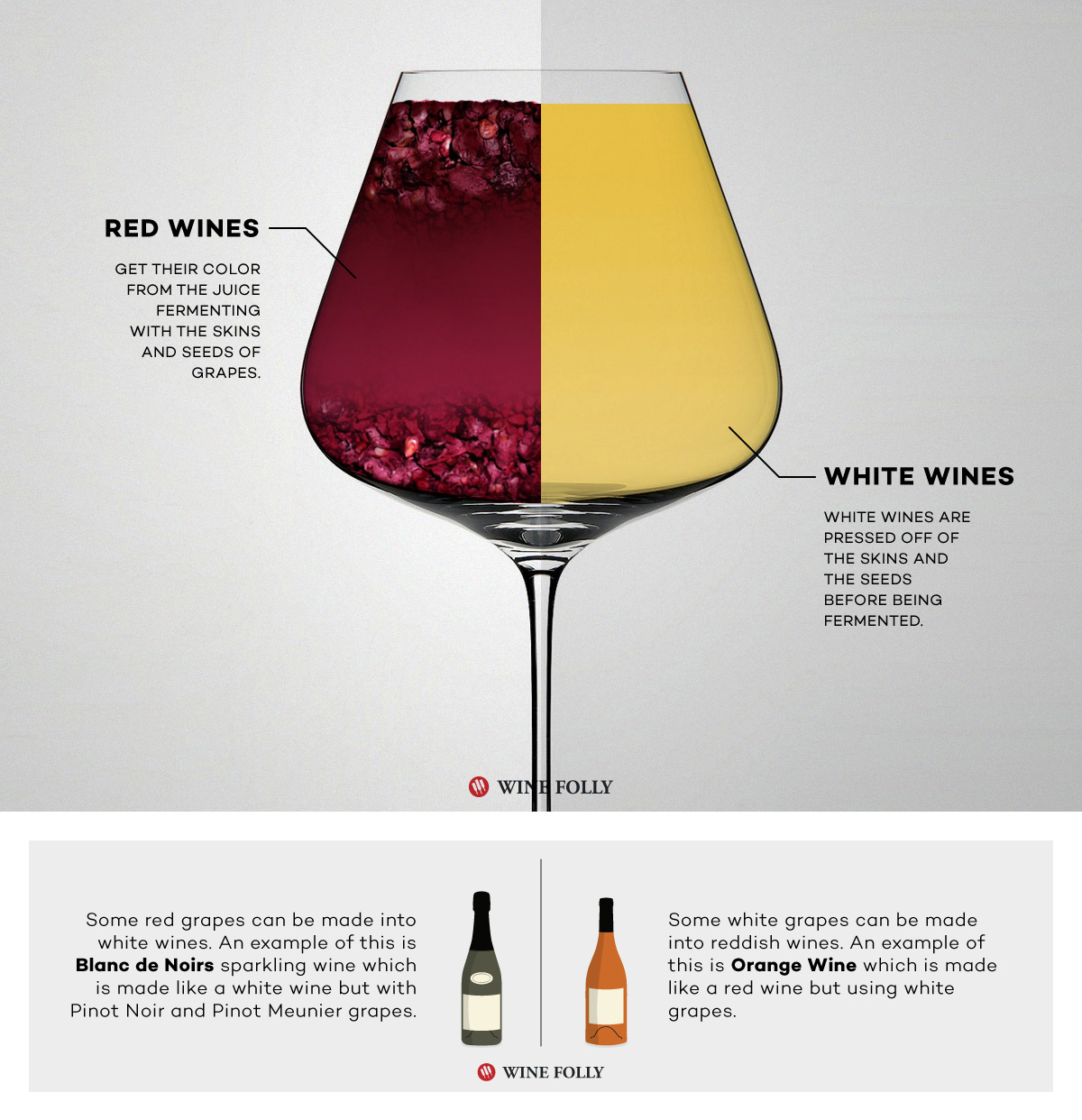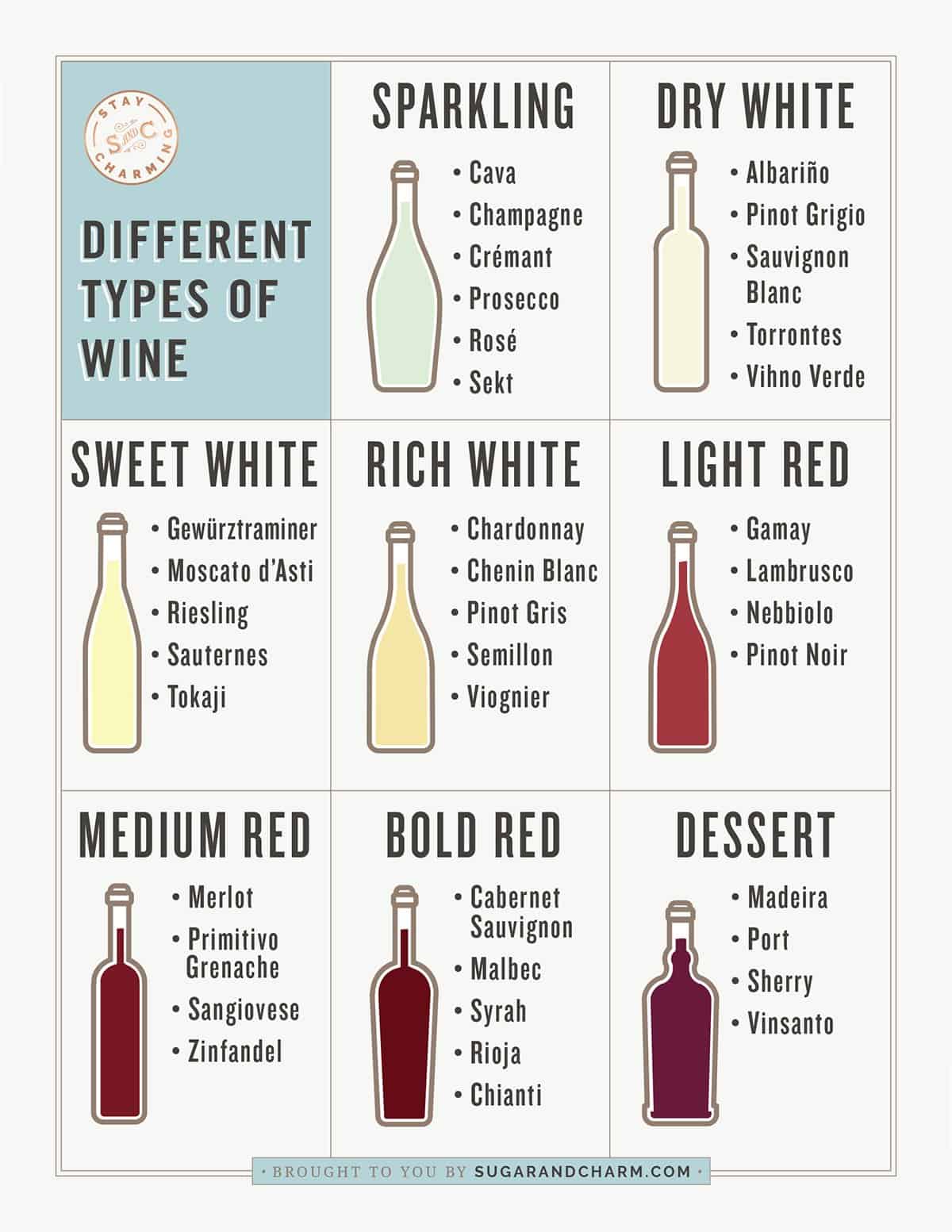White Vs Red Wine: A Comprehensive Comparison

White vs Red Wine: A Comprehensive Comparison:
When it comes to comparing white and red wine, there are several key differences to consider. White wines are known for their refreshing and vibrant taste profile, with lighter bodies and a wide range of flavors that can vary based on factors such as grape variety, region, and winemaking techniques. On the other hand, red wines are characterized by their bold and robust flavors, often with higher tannin levels and aging potential. Understanding these differences can help you choose the perfect wine for any occasion, whether it be a light and crisp white or a rich and full-bodied red.
Key Differences Between White And Red Wine
White and red wines have several key differences that contribute to their distinct flavor profiles and characteristics. The main difference lies in the grape varieties used and the winemaking process. White wines are made from green or yellow grapes, with the skins removed before fermentation, resulting in a lighter and more crisp flavor. Red wines, on the other hand, are made from red or purple grapes, with the skins left on during fermentation, leading to a deeper and richer flavor. Additionally, red wines generally have higher tannin levels and can be aged for longer periods, while white wines are typically served younger and are known for their refreshing qualities.
Factors Affecting The Taste And Aroma Of White And Red Wine
The taste and aroma of white and red wines are influenced by a variety of factors. Firstly, the grape variety plays a significant role. Different grape varieties possess distinct flavors and aromas. Secondly, the climate and soil in which the grapes are grown contribute to the wine’s characteristics. Cooler climates can produce wines with higher acidity and lighter flavors, while warmer climates can result in fuller-bodied and richer wines. The winemaking process, including fermentation and aging techniques, also affects the taste and aroma. Finally, storage conditions and serving temperature can further enhance or diminish the wine’s characteristics.
Popular Varietals Of White Wine And Their Characteristics

There are several popular varietals of white wine, each with its own unique characteristics.
- Chardonnay: Chardonnay is a versatile and widely-grown white wine grape. It can range from light and crisp to rich and buttery, depending on the region and winemaking techniques.
- Sauvignon Blanc: Sauvignon Blanc is known for its refreshing acidity and vibrant flavors. It often exhibits notes of citrus, tropical fruits, and grass, with regional variations adding complexity.
- Riesling: Riesling is known for its aromatic nature and can range from dry to sweet. It often showcases flavors of apple, pear, and floral notes, with a characteristic acidity that balances the sweetness.
- Pinot Grigio: Pinot Grigio is light and refreshing, with flavors of citrus, green apple, and melon. It is typically dry and crisp, making it a popular choice for summertime sipping.
These varietals offer a wide range of flavors and styles, allowing wine lovers to find their perfect match.
Chardonnay: Flavor Profile And Food Pairing
Chardonnay is a versatile white wine that offers a range of flavor profiles, making it a beloved choice among wine enthusiasts. It can showcase aromas of apples, pears, citrus, and tropical fruits, with variations depending on factors such as oak aging or cool climate. The taste of Chardonnay can range from crisp and refreshing to rich and buttery, offering a delightful balance of acidity and smoothness. When it comes to food pairing, Chardonnay pairs well with a variety of dishes, including roasted chicken, seafood, grilled vegetables, and creamy cheeses. Its versatility makes it an excellent choice for both casual and formal dining occasions.
Sauvignon Blanc: Aroma And Regional Variations
Sauvignon Blanc is a white wine known for its distinct aroma and regional variations. It is known for its vibrant and aromatic qualities, often described as herbaceous or grassy, with hints of tropical fruits and citrus. The aroma of Sauvignon Blanc can vary depending on the region where it is grown. In cooler climates such as New Zealand and the Loire Valley in France, it tends to have more pronounced citrus and passion fruit notes. In warmer regions like California, it can display riper flavors of melon and peach. These regional variations contribute to the diversity and versatility of Sauvignon Blanc, making it a popular choice for wine enthusiasts.
Popular Varietals Of Red Wine And Their Characteristics

Red wine is known for its rich flavors and complex characteristics. Some popular varietals of red wine include Cabernet Sauvignon, Merlot, Pinot Noir, Syrah, and Zinfandel.
- Cabernet Sauvignon: Known for its boldness and high tannin levels, Cabernet Sauvignon typically offers flavors of blackcurrant, blackberry, and cedar.
- Merlot: With its softer tannins and medium body, Merlot is known for its ripe fruit flavors such as plum, cherry, and chocolate.
- Pinot Noir: A lighter red wine, Pinot Noir showcases flavors of red cherry, strawberry, and earthy undertones.
- Syrah: Offering intense flavors of dark fruits, black pepper, and spices, Syrah is a full-bodied red wine.
- Zinfandel: Zinfandel is known for its jammy fruit flavors, spice notes, and high alcohol content.
Each varietal has its own unique characteristics, making it a matter of personal preference when choosing a red wine.
Cabernet Sauvignon: Tannin Levels And Aging Potential
Cabernet Sauvignon is well-known for its boldness and high levels of tannin, which gives it its characteristic astringency and structure. The tannins in Cabernet Sauvignon come from the grape’s thick skin and seeds. These tannins provide the wine with aging potential, allowing it to develop more complexity and smoothness over time. Cabernet Sauvignon is known to benefit from aging in oak barrels, which further enhances its flavors and aromas. With proper storage and aging, Cabernet Sauvignon can reveal layers of flavors like blackcurrant, blackberry, and cedar, making it a favorite among wine enthusiasts.
Merlot: Softness And Versatility In Pairing
Merlot is known for its soft tannins and versatility, making it a perfect wine to pair with a wide range of dishes. Its smoothness and medium body make it an excellent choice for pairing with red meats like grilled or roasted beef and lamb. The fruity flavors of black cherry, blackberry, plum, and raspberry in Merlot also make it a great match for dishes featuring tomato-based sauces or roasted vegetables. Whether it’s a hearty pasta dish, a cheese platter, or even a chocolate dessert, Merlot’s softness and versatility are sure to complement and enhance the flavors of your meal.
White Vs Red Wine: Health Benefits And Nutritional Value

When it comes to health benefits and nutritional value, both white and red wine have their own advantages. White wine is typically lower in calories and carbohydrates compared to red wine. On the other hand, red wine contains higher levels of certain vitamins and minerals due to its fermentation process with grape skins and seeds. Both types of wine also contain antioxidants that can help reduce the risk of heart disease. However, it’s important to consume wine in moderation as excessive alcohol intake can have negative health effects.
Antioxidants In Red Wine Vs White Wine
Red wine and white wine both contain antioxidants, but red wine generally has higher levels due to its fermentation process with grape skins and seeds. The antioxidants in red wine, such as resveratrol, have been linked to various health benefits, including reducing inflammation and lowering the risk of heart disease. While white wine may have fewer antioxidants than red wine, it can still provide some health benefits, such as supporting lung function and potentially reducing the risk of certain cancers. It’s important to remember that moderation is key when consuming wine for its antioxidant benefits.
Impact Of Resveratrol On Heart Health
Resveratrol, a powerful antioxidant found in red wine, has been extensively studied for its potential impact on heart health. Research suggests that resveratrol may have cardioprotective effects by improving cardiovascular function and reducing the risk of heart disease. It has been shown to enhance the production of nitric oxide, a molecule that helps relax and dilate blood vessels, leading to improved blood flow. Additionally, resveratrol has anti-inflammatory properties that can help reduce inflammation in the cardiovascular system. While more research is needed, incorporating moderate amounts of red wine, rich in resveratrol, into a balanced diet may contribute to heart health.
Serving And Enjoyment Tips For White And Red Wine

When serving white wine, it is generally recommended to chill the bottle in the refrigerator for about 2 hours before serving. This ensures that the wine is at the ideal temperature, which is typically between 45°F and 50°F. For red wine, it is best to serve it slightly below room temperature, around 60°F to 65°F.
To enhance the enjoyment of white wine, it is advised to use tall, narrow glasses to preserve the delicate aromas. For red wine, opt for wider glasses with a larger opening to allow the wine’s aromas to fully develop. It is also recommended to decant red wines, especially those that are young and tannic, to allow them to breathe and soften.
When pouring, fill the glasses about one-third full to allow room for swirling and releasing the wine’s aromas. Remember to hold the glass by the stem to avoid warming the wine with your hand.
Lastly, take your time to savor and appreciate the flavors and aromas of both white and red wine. Experiment with food pairings and discover the unique characteristics of each varietal to truly enjoy your wine experience.
Ideal Serving Temperatures And Glassware
When it comes to serving white and red wine, the temperature at which they are served greatly impacts the overall experience. White wine is best enjoyed when chilled between 45°F and 50°F. To preserve its delicate aromas, it is recommended to use tall, narrow glasses that help maintain a cooler temperature. On the other hand, red wine should be served slightly below room temperature, around 60°F to 65°F. Wider glasses with larger openings are ideal for red wine, allowing the wine’s aromas to fully develop. Regardless of the type of wine, holding the glass by the stem avoids warming the wine with your hand and enhances the tasting experience.
Wine And Food Pairing Recommendations
When it comes to pairing wine with food, there are certain guidelines that can help enhance the overall dining experience. It is generally recommended to pair red wine with red meats and hearty dishes. For example, a rich Cabernet Sauvignon complements a juicy grilled steak perfectly. On the other hand, white wines are best paired with lighter flavors such as fish and poultry. A crisp Chardonnay can beautifully enhance the taste of a grilled chicken breast. However, it’s important to experiment and find your own personal preferences when it comes to wine and food pairing.
Conclusion

In conclusion, the comparison between white and red wine reveals a multitude of differences in terms of color, grape varieties, flavor profiles, health benefits, and food pairing options. White wines tend to be lighter and crisper, complementing fish and poultry dishes, while red wines are bolder and pair well with red meats. Each variety offers its own unique characteristics and can enhance the dining experience in different ways. Ultimately, personal preferences play a significant role in determining one’s wine choice. Whether you prefer the freshness of a Chardonnay or the richness of a Cabernet Sauvignon, exploring different wine varietals is a delightful journey in itself.
Summary Of Contrasting Features Of White And Red Wine
White and red wine have distinct differences that set them apart. White wine is typically lighter in color, while red wine has a deep red hue. These variations are due to the grape varieties used. White wine offers crispness and freshness, while red wine is bolder and richer. In terms of health benefits, red wine is known for its antioxidants, such as resveratrol, which can promote heart health. When it comes to food pairing, white wine complements fish and poultry dishes, while red wine is a better match for red meats. Personal preferences play a significant role in choosing between the two varieties.
Personal Preferences And Exploring Different Wine Varietals
When it comes to wine, personal preferences play a significant role. Some individuals have a strong affinity for white wine, while others prefer the boldness of red wine. However, it is also important to explore different wine varietals to expand one’s wine knowledge and palate. Exploring lesser-known grape varieties and unique wine regions can introduce new flavors and aromas that are sure to delight and surprise. By trying different wine varietals, individuals can discover their own personal favorites while also gaining a deeper appreciation for the diverse world of wine.
FAQ About White Vs Red Wine: Contrasting Wine Varietals
Q: What are the main differences between white and red wines?
A: The primary differences between white and red wines lie in the grape varieties used, the winemaking process, and the aging process. White wines are made from green or yellow grapes with the skins removed, while red wines use dark-colored grapes with the skins left on during fermentation.
Q: How does the taste of white wine differ from red wine?
A: White wines are generally lighter-bodied, crisper, and more acidic compared to red wines. White wines often exhibit flavors of citrus, green fruits, and floral notes, while red wines are richer, more complex, and can showcase flavors ranging from red fruits like cherries to dark fruits like blackberries.
Q: Are the health benefits of white and red wine the same?
A: While both white and red wines contain antioxidants and polyphenols that may offer health benefits, red wine typically contains higher levels of resveratrol due to extended contact with grape skins during fermentation. Resveratrol is believed to have heart-healthy properties.
Q: Which foods pair better with white wine versus red wine?
A: White wines tend to pair well with lighter dishes such as seafood, salads, poultry, and creamy pasta sauces. Red wines are usually better suited for richer, more robust dishes like red meats, stews, and dishes with tomato-based sauces.
Q: What are some popular varieties of white and red wines?
A: Popular white wine varieties include Chardonnay, Sauvignon Blanc, Riesling, and Pinot Grigio. Common red wine varieties include Cabernet Sauvignon, Merlot, Pinot Noir, and Shiraz (Syrah).
Q: Do white wines need to be served colder than red wines?
A: Yes, white wines are generally served chilled to enhance their crispness and acidity, while red wines are served at a slightly cooler room temperature to showcase their complexities and flavors.
Q: Can white wine be aged like red wine?
A: While some premium white wines, such as certain Chardonnays and Rieslings, can benefit from aging to develop more nuanced flavors, the majority of white wines are meant to be consumed relatively young to preserve their fresh and fruity characteristics.

Bistro La Casona is a charming and vibrant culinary destination located at Calle Arenales 222, nestled between Murillo and Aroma in the heart of Casco Viejo/Centro Histórico, Santa Cruz de la Sierra, Bolivia. Our story is one of passion, creativity, and a deep love for exceptional dining experiences. Bistro La Casona has carved out a niche for itself as a beacon of culinary excellence in the heart of the historical center of Santa Cruz de la Sierra. Our journey began with a simple idea – to create a space where food, ambiance, and hospitality come together to offer an unforgettable experience.